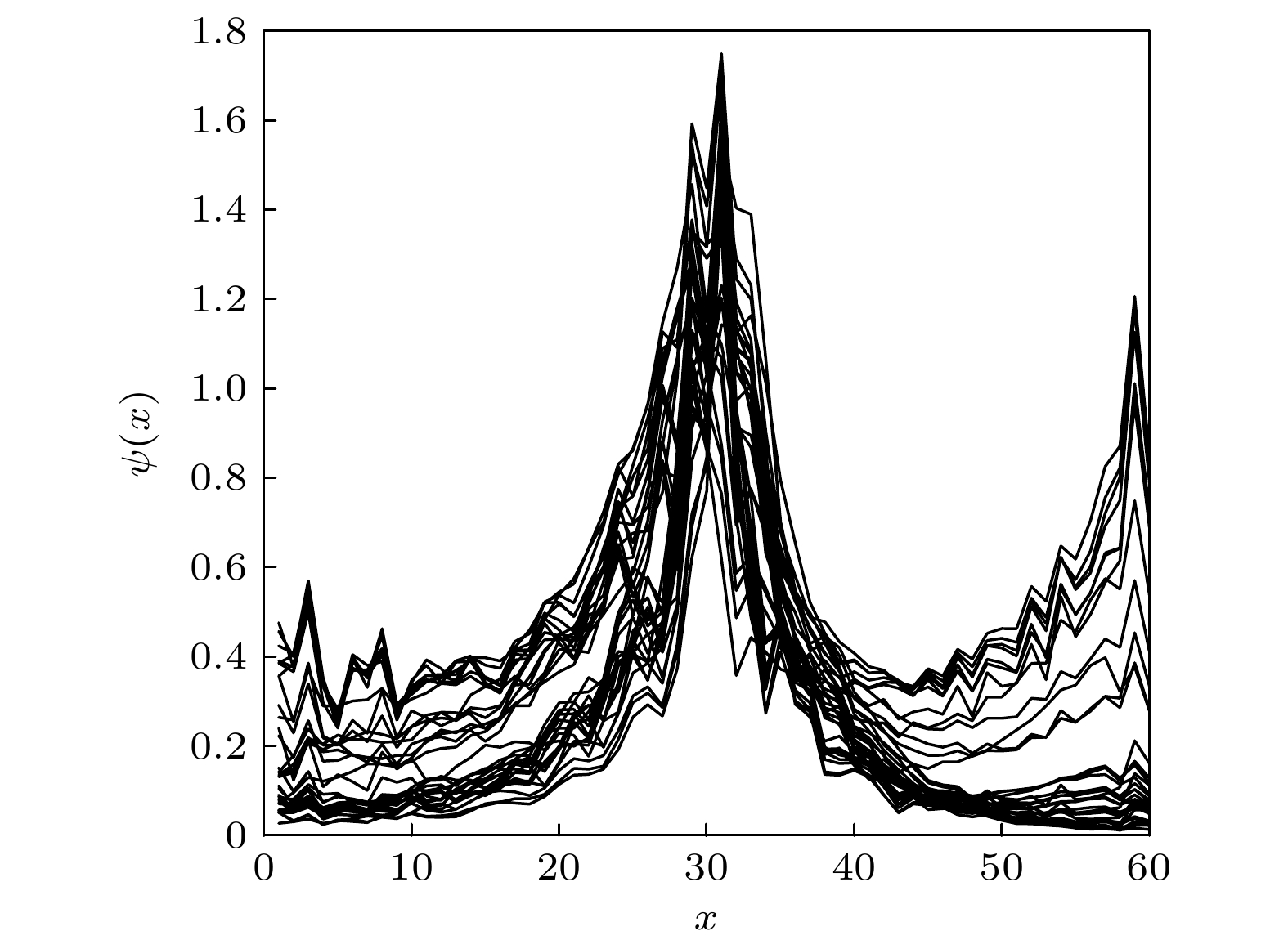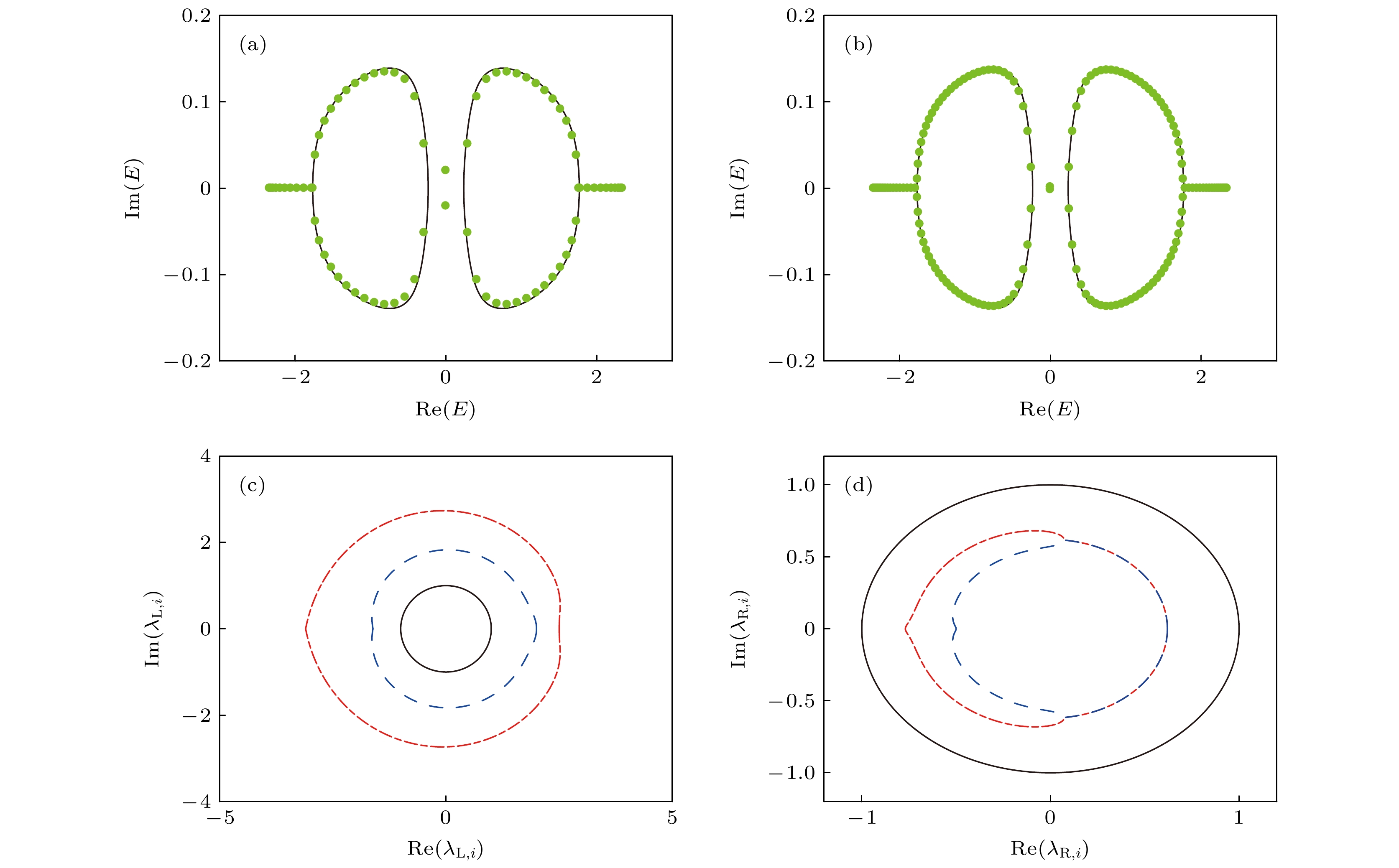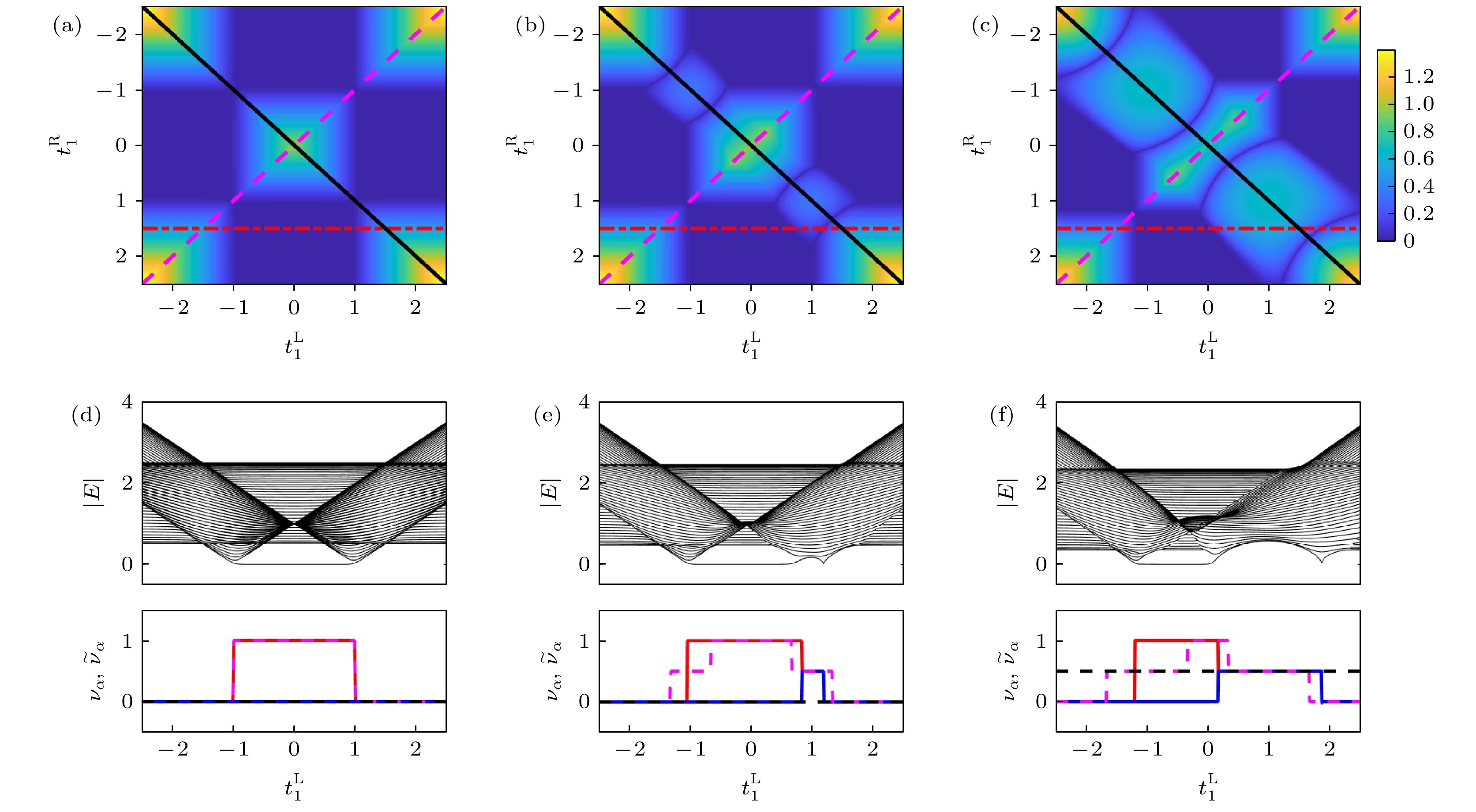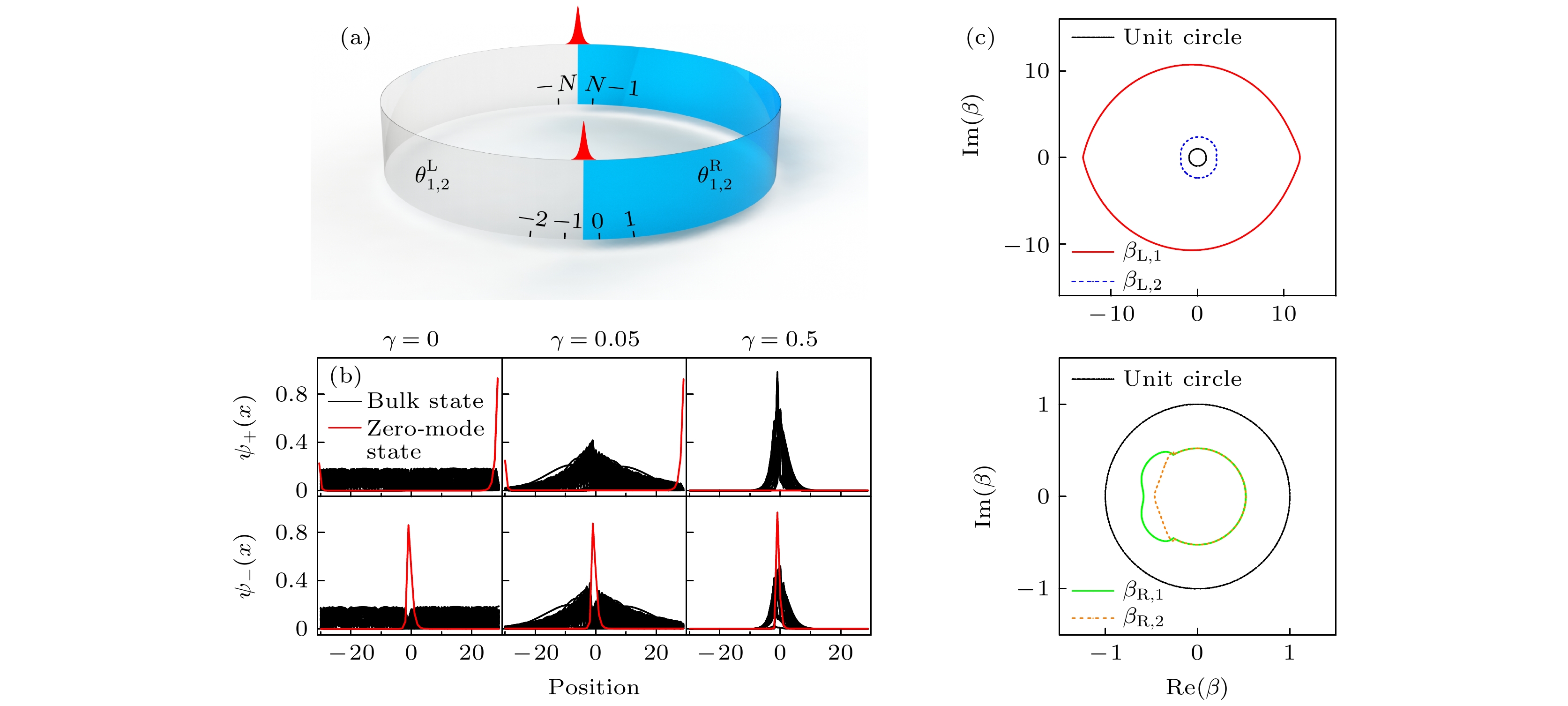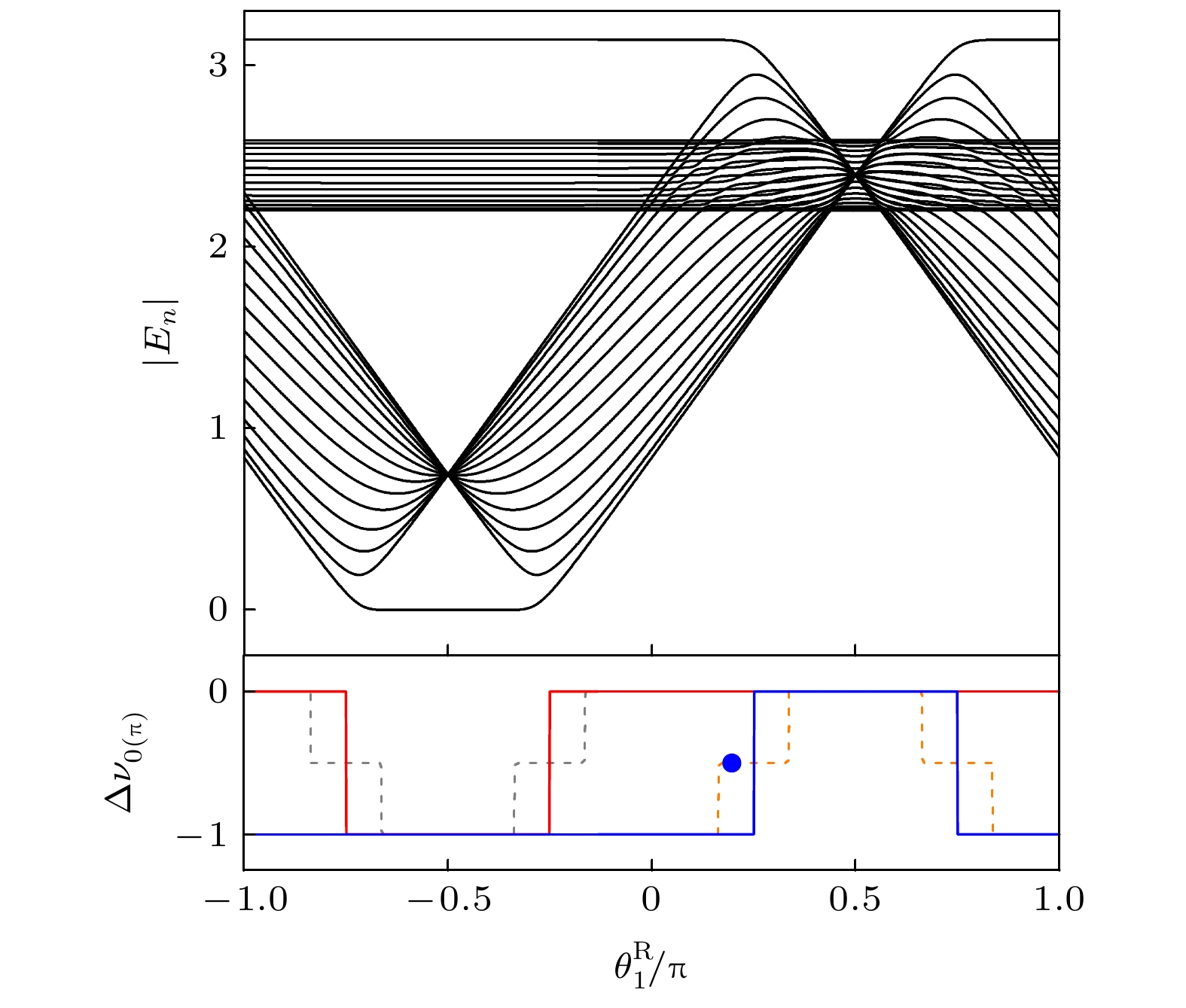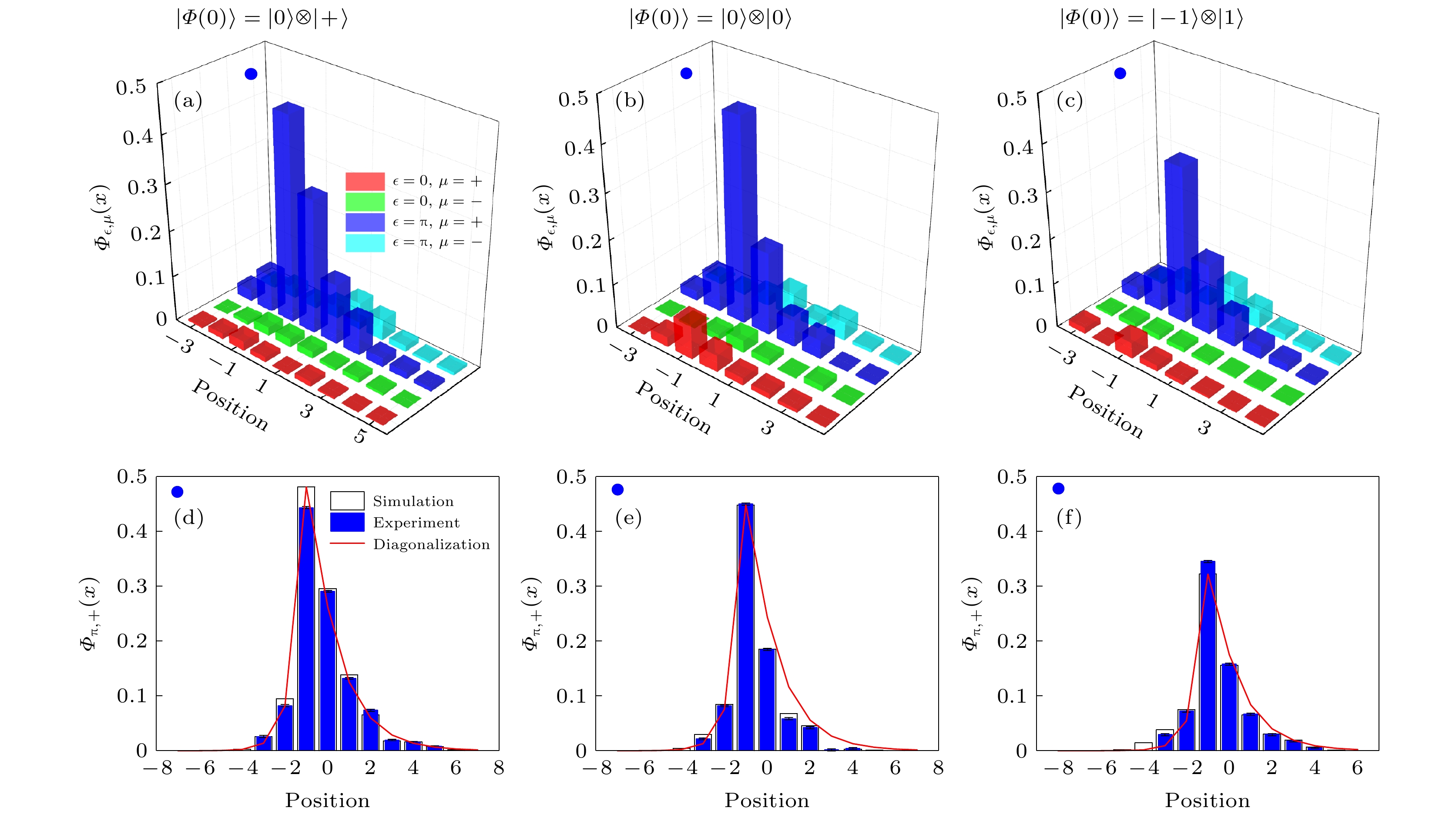-
非厄米趋肤效应是近几年非厄米物理研究领域中的热点问题, 它揭示了非厄米系统中体态波函数和能谱计算会敏感依赖于边界条件的新奇现象. 人们提出广义布里渊区的概念用以刻画非厄米系统中的体态波函数和能带性质. 基于广义布里渊区计算的非布洛赫拓扑数可以重新构建非厄米拓扑体边对应关系. 然而, 过去关于非厄米趋肤效应的讨论主要针对开放边界条件, 如果采用畴壁边界条件, 广义布里渊区和非布洛赫拓扑数的计算都需要重新考虑. 本文综述了近几年关于畴壁边界条件下非厄米趋肤效应的若干研究工作, 首先从一般的一维非厄米单带模型出发, 推导广义布里渊区方程的一般形式; 然后回顾了非厄米SSH (Su-Schieffer-Heeger)模型中广义布里渊区和非布洛赫拓扑数的计算; 最后在一维光量子行走的系统中, 介绍了实验上非厄米趋肤效应的实现和非厄米拓扑边缘态的探测.
-
关键词:
- 畴壁边界条件 /
- 非厄米趋肤效应 /
- 非布洛赫能带理论 /
- 非厄米拓扑体边对应关系
The non-Hermitian skin effect is one of the most striking features in non-Hermitian physics. It reveals a novel phenomenon in a non-Hermitian system that the bulk wave function and energy spectrum are sensitively dependent on the boundary conditions. The concept of generalized Brillouin zones has been proposed to characterize bulk wave functions in such systems . Based on generalized Brillouin zones, non-Bloch topological invariants can reconstruct the non-Hermitian bulk-edge correspondence. Previous discussion of the non-Hermitian skin effect mainly focused on open boundary conditions, and the calculation of generalized Brillouin zones needs to be reconsidered under domain-wall boundary conditions. The paper introduces the related researches of the non-Hermitian skin effect in domain-wall systems, including the general form of the generalized Brillouin zone equation in a one-dimensional single-band model, non-Bloch topological invariants in non-Hermitian SSH (Su-Schieffer-Heeger) model, and the experimental realization of the non-Hermitian skin effect in one-dimensional quantum walk system.-
Keywords:
- domain-wall system /
- non-Hermitian skin effect /
- non-Bloch band theory /
- non-Hermitian bulk-edge correspondence
[1] Breuer H P, Petruccione F 2006 The Theory of Open Quantum Systems (Oxford: Oxford University Press)
[2] Lindblad G 1976 Commun. Math. Phys. 48 119
 Google Scholar
Google Scholar
[3] Dalibard J, Castin Y, Molmer K 1992 Phys. Rev. Lett. 68 580
 Google Scholar
Google Scholar
[4] Carmichael H J 1993 Phys. Rev. Lett. 70 2273
 Google Scholar
Google Scholar
[5] Prosen T 2010 J. Stat. Mech. P 07020
 Google Scholar
Google Scholar
[6] Prosen T 2008 New J. Phys. 10 043026
 Google Scholar
Google Scholar
[7] Zhou Y N, Mao L, Zhai H 2021 Phys. Rev. Res. 3 043060
 Google Scholar
Google Scholar
[8] Shen H, Zhen B, Fu L 2018 Phys. Rev. Lett. 120 146402
 Google Scholar
Google Scholar
[9] Gong Z, Ashida Y, Kawabata K, Takasan K, Higashikawa S, Ueda M 2018 Phys. Rev. X 8 031079
 Google Scholar
Google Scholar
[10] Kawabata K, Shiozaki K, Ueda M, Sato M 2019 Phys. Rev. X 9 041015
[11] Ghatak A, Das T 2019 J. Phys. Condens. Matter 31 263001
 Google Scholar
Google Scholar
[12] Bergholtz E J, Budich J C, Kunst F K 2021 Rev. Mod. Phys. 93 015005
 Google Scholar
Google Scholar
[13] Zhen B, Hsu C W, Igarashi Y, et al. 2015 Nature 525 354
 Google Scholar
Google Scholar
[14] Poli C, Bellec M, Kuhl U, Mortessagne F, Schomerus H 2015 Nat. Commun. 6 6710
 Google Scholar
Google Scholar
[15] Zhu W, Fang X, Li D, Sun Y, Li Y, Jing Y, Chen H 2018 Phys. Rev. Lett. 121 124501
 Google Scholar
Google Scholar
[16] Li J, Harter A K, Liu J, Melo L D, Joglekar Y N, Luo L 2019 Nat. Commun. 10 855
 Google Scholar
Google Scholar
[17] Xiao L, Deng T, Wang K, Zhu G, Wang Z, Yi W, Xue P 2020 Nat. Phys. 16 761
 Google Scholar
Google Scholar
[18] Ding L, Shi K, Zhang Q, Shen D, Zhang X, Zhang W 2021 Phys. Rev. Lett. 126 083604
 Google Scholar
Google Scholar
[19] Zou D, Chen T, He W, Bao J, Lee C H, Sun H, Zhang X 2021 Nat. Commun. 12 7201
 Google Scholar
Google Scholar
[20] Lee T E 2016 Phys. Rev. Lett. 116 133903
 Google Scholar
Google Scholar
[21] Yao S, Wang Z 2018 Phys. Rev. Lett. 121 086803
 Google Scholar
Google Scholar
[22] Yao S, Song F, Wang Z 2018 Phys. Rev. Lett. 121 136802
 Google Scholar
Google Scholar
[23] Kunst F K, Edvardsson E, Budich J C, Bergholtz E J 2018 Phys. Rev. Lett. 121 026808
 Google Scholar
Google Scholar
[24] Lee C H, Thomale R 2019 Phys. Rev. B 99 201103(R
 Google Scholar
Google Scholar
[25] 胡渝民, 宋飞, 汪忠 2021 物理学报 70 230307
 Google Scholar
Google Scholar
Hu Y M, Song F, Wang Z 2021 Acta Phys. Sin. 70 230307
 Google Scholar
Google Scholar
[26] Yokomizo K, Murakami S 2019 Phys. Rev. Lett. 123 066404
 Google Scholar
Google Scholar
[27] Song F, Yao S, Wang Z 2019 Phys. Rev. Lett. 123 170401
 Google Scholar
Google Scholar
[28] Jiang H, Lang L J, Yang C, Zhu S L, Chen S 2019 Phys. Rev. B 100 054301
 Google Scholar
Google Scholar
[29] Okuma N, Kawabata K, Shiozaki K, Sato M 2020 Phys. Rev. Lett. 124 086801
 Google Scholar
Google Scholar
[30] Zhang K, Yang Z, Fang C 2020 Phys. Rev. Lett. 125 126402
 Google Scholar
Google Scholar
[31] Yang Z, Zhang K, Fang C, Hu J 2020 Phys. Rev. Lett. 125 226402
 Google Scholar
Google Scholar
[32] Mao L, Deng T, Zhang P 2021 Phys. Rev. B 104 125435
 Google Scholar
Google Scholar
[33] Sun X Q, Zhu P, Hughes T L 2021 Phys. Rev. Lett. 127 066401
 Google Scholar
Google Scholar
[34] Liu C H, Zhang K, Yang Z, Chen S 2020 Phys. Rev. Res. 2 043167
 Google Scholar
Google Scholar
[35] Li L, Lee C H, Mu S, Gong J 2020 Nat. Commun. 11 5491
 Google Scholar
Google Scholar
[36] Claes J, Hughes T L 2021 Phys. Rev. B 103 L140201
 Google Scholar
Google Scholar
[37] Xue W T, Li M R, Hu Y M, Song F, Wang Z 2021 Phys. Rev. B 103 L241408
 Google Scholar
Google Scholar
[38] Okuma N, Sato M 2021 Phys. Rev. B 103 085428
 Google Scholar
Google Scholar
[39] Guo C X, Liu C H, Zhao X M, Liu Y, Chen S 2021 Phys. Rev. Lett. 127 116801
 Google Scholar
Google Scholar
[40] Xue W T, Hu Y M, Song F, Wang Z 2022 Phys. Rev. Lett. 128 120401
 Google Scholar
Google Scholar
[41] Lv C, Zhang R, Zhai Z, Zhou Q 2022 Nat. Commun. 13 2184
 Google Scholar
Google Scholar
[42] Zhou T G, Zhou Y N, Zhang P, Zhai H 2022 Phys. Rev. Research 4 L022039
 Google Scholar
Google Scholar
[43] Zhang K, Yang Z, Fang C 2022 Nat. Commun. 13 2496
 Google Scholar
Google Scholar
[44] Deng T S, Yi W 2019 Phys. Rev. B 100 035102
 Google Scholar
Google Scholar
[45] Hasan M Z, Kane C L 2010 Rev. Mod. Phys. 82 3045
 Google Scholar
Google Scholar
[46] Qi X L, Zhang S C 2011 Rev. Mod. Phys. 83 1057
 Google Scholar
Google Scholar
[47] Chiu C K, Teo J C Y, Schnyder A P, Ryu S 2016 Rev. Mod. Phys. 88 035005
 Google Scholar
Google Scholar
[48] Yin C, Jiang H, Li L, Lü R, Chen S 2018 Phys. Rev. A 97 052115
 Google Scholar
Google Scholar
[49] Lieu S 2018 Phys. Rev. B 97 045106
 Google Scholar
Google Scholar
[50] Shenvi N, Kempe J, Birgitta Whaley K 2003 Phys. Rev. A 62 052307
 Google Scholar
Google Scholar
[51] Ambainis A 2003 Int. J. Quantum. Inform. 1 507
 Google Scholar
Google Scholar
[52] Kitagawa T, Rudner M S, Berg E, Demler E 2010 Phys. Rev. A 82 033429
 Google Scholar
Google Scholar
[53] Cardano F, Maffei F, Massa F, et al. 2016 Nat. Commun. 7 11439
 Google Scholar
Google Scholar
[54] Flurin E, Ramasesh V V, Hacohen-Gourgy S, Martin L S, Yao N Y, Siddiqi I 2017 Phys. Rev. X 7 031023
 Google Scholar
Google Scholar
[55] Cardano F, DErrico A, Dauphin A, et al. 2017 Nat. Commun. 8 15516
 Google Scholar
Google Scholar
[56] Xiao L, Zhan X, Bian Z H, et al. 2017 Nat. Phys. 13 1117
 Google Scholar
Google Scholar
[57] Zhan X, Xiao L, Bian Z, et al. 2017 Phys. Rev. Lett. 119 130501
 Google Scholar
Google Scholar
[58] Wang K K, Qiu X, Xiao L, et al. 2019 Nat. Commun. 10 2293
 Google Scholar
Google Scholar
[59] Asbóth J K, Obuse H 2013 Phys. Rev. B 88 121406
 Google Scholar
Google Scholar
[60] Asbóth J K, Tarasinski B, Delplace P 2014 Phys. Rev. B 90 125143
 Google Scholar
Google Scholar
[61] Yao S, Yan Z, Wang Z 2017 Phys. Rev. B 96 195303
 Google Scholar
Google Scholar
[62] Roy R, Harper F 2017 Phys. Rev. B 96 155118
 Google Scholar
Google Scholar
[63] Rudner M S, Lindner N H 2020 Nat. Rev. Phys. 2 229
 Google Scholar
Google Scholar
-
图 2 波函数在实空间的分布图. 其中
$m=2$ ,$t_{{\rm{M}}, 1}=t_{{\rm{M}}, 2}= $ $ t_{{\rm{M}}, -1}=t_{{\rm{M}}, -2}=1$ ,$t_{{\rm{L}}, -2}=4$ ,$t_{{\rm{L}}, -1}=-1$ ,$t_{{\rm{L}}, 1}=3$ ,$t_{{\rm{L}}, 2}=2$ ,$t_{{\rm{R}}, -2}=2$ ,$t_{{\rm{R}}, -1}=1$ ,$t_{{\rm{R}}, 1}=3$ ,$t_{{\rm{R}}, 2}=-2$ ,$N=30$ Fig. 2. Wave-function distribution in real space. Here,
$m=2$ ,$t_{{\rm{M}}, 1}=t_{{\rm{M}}, 2}=t_{{\rm{M}}, -1}=t_{{\rm{M}}, -2}=1$ ,$t_{{\rm{L}}, -2}=4$ ,$t_{{\rm{L}}, -1}=-1$ ,$t_{{\rm{L}}, 1}=3$ ,$t_{{\rm{L}}, 2}=2$ ,$t_{{\rm{R}}, -2}=2$ ,$t_{{\rm{R}}, -1}=1$ ,$t_{{\rm{R}}, 1}=3$ ,$t_{{\rm{R}}, 2}=-2$ ,$N=30$ 图 3 畴壁边界条件下的非厄米SSH模型. 在左边(右边)区域元胞内部a子格到b子格的跃迁是
$t^{{\rm{L}}({\rm{R}})}_1-\gamma/2$ , 而元胞内部b子格到a子格的是$t^{{\rm{L}}({\rm{R}})}_1+\gamma/2$ . 此外, 畴壁两边不同区域具有相同的$t_2$ 和$\gamma$ [44]Fig. 3. A non-Hermitian SSH model with two bulks. For left (right) bulk, the intra-cell hopping from a-site to b-site is
$t_1^{{\rm{L}}({\rm{R}})}-\gamma/2$ while the intra-cell hopping from b-site to a-site is$t_1^{{\rm{L}}({\rm{R}})}+\gamma/2$ . Also, different bulks holds same$t_2$ and$\gamma$ [44]图 4 (a), (b)体态波函数的理论(黑线)和数值(绿点)结果, (a)图的链长为
$N=20$ , (b) 图的链长为$N=40$ . (c) 复平面内$\beta_{{\rm{L}}, 1}$ (红色点划线)和$\beta_{{\rm{L}}, 2}$ (蓝色虚线)表示的左链的非布洛赫布里渊区. (d) 复平面内$\beta_{{\rm{R}}, 1}$ (红色点划线)和$\beta_{{\rm{R}}, 2}$ (蓝色虚线)表示的右链的非布洛赫布里渊区. 在图(c)和图(d)中, 取热力学极限$N\rightarrow \infty$ 并且用黑色实线画出了布洛赫布里渊区作为对比. 在所有的子图中, 选取的参数为$t_1^{\rm{L}}=-t_2$ ,$t_1^{\rm{R}}=1.5 t_2$ ,$\gamma=1.33 t_2$ [44]Fig. 4. (a), (b) Theoretical (black lines) and numerical (green dots) results of bulk-state energy spectrum. The length of chain is
$N=20$ for panel (a) and$N=40$ for panel (b). (c) Non-Bloch Brillouin zones of the left bulk, represented by$\beta_{{\rm{L}}, 1}$ (red dash-dotted line) and$\beta_{{\rm{L}}, 2}$ (blue dashed line) on the complex plane. (d) Non-Bloch Brillouin zones of the right bulk, represented by$\beta_{{\rm{R}}, 1}$ (red dash-dotted line) and$\beta_{{\rm{R}}, 2}$ (blue dashed line) on the complex plane. In panels (c) and (d), we take the thermodynamic limit$N\rightarrow \infty$ , and we also plot the Bloch Brillouin zones with black solid lines for comparison. For all subplots, we take$t_1^{\rm{L}}=-t_2$ ,$t_1^{\rm{R}}=1.5 t_2$ ,$\gamma=1.33 t_2$ [44]图 5 (a)—(c)颜色栏在
$t_1^{\rm{L}}$ -$t_1^{\rm{R}}$ 平面能谱绝对值的最小值. 这里选取$N=40$ . 图(a)中$\gamma=0$ , 图(b)中$\gamma=0.67 \;t_2$ , 图(c)中$\gamma=1.33 \;t_2$ . 黑色线对应参数$t_1^{\rm{L}}=t_1^{\rm{R}}$ , 此时畴壁构型会退化回周期边界条件的均匀格点模型. 玫红色的虚线对应的参数为$t_1^{\rm{L}}=-t_1^{\rm{R}}$ . 图(a)—(c)里的红色点划线给出了用在图(d)—(f)里的参数, 即$t_1^{\rm{R}}=1.5\; t_2$ . (d)—(f)能谱绝对值(上部)和拓扑数(下部). 图中下部给出了左链的布洛赫拓扑数$\nu_{\rm{L}}$ (玫红虚线) 和右链的非布洛赫拓扑数$\nu_{\rm{R}}$ (黑色虚线), 以及左链的非布洛赫拓扑数$\tilde{\nu}_{\rm{L}}$ (红色实线)和右链的非布洛赫拓扑数$\tilde{\nu}_{\rm{R}}$ (蓝色实线)[44]Fig. 5. (a)–(c) Contour plots of absolute values of the energy-spectrum minimum on the
$t_1^{\rm{L}}$ -$t_1^{\rm{R}}$ plane. Here, we take$N=40$ . We also take$\gamma=0$ for (a),$\gamma=0.67 \;t_2$ for (b) and$\gamma=1.33 \;t_2$ for (c). The black solid lines are given by$t_1^{\rm{L}}=t_1^{\rm{R}}$ , where the domain-wall configuration is reduced to single homogeneous bulk with a periodic boundary condition. The magenta dashed lines are given by$t_1^{\rm{L}}=-t_1^{\rm{R}}$ . The red dashed-dotted line in panels (a)–(c) correspond to parameters we use in panels (d)–(f) with$t_1^{\rm{R}}=1.5 \;t_2$ . (d)–(f) The absolute values of the energy spectrum (upper panels) and various winding numbers (lower panels). In the lower panel, we show the Bloch winding numbers for the left bulk$\nu_{\rm{L}}$ (magenta dashed lines) and the right bulk$\nu_{\rm{R}}$ (black dashed lines), as well as non-Bloch winding numbers for the left bulk$\tilde{\nu}_{\rm{L}}$ (red solid lines) and the right bulk$\tilde{\nu}_{\rm{R}}$ (blue solid lines)[44]图 6 具有非厄米趋肤效应的量子行走 (a) 畴壁边界条件示意图; (b) 体态波函数(黑色)和边缘态波函数(红色)的空间分布, 其中
$\psi_\pm(x)=\big|\left(\langle x|\otimes\langle \pm |\right)|\psi\rangle\big|$ ,$|\pm\rangle=(|0\rangle\pm|1\rangle)/\sqrt{2}$ 是手征对称算符的本征态; (c) 左边(右边)区域的广义布里渊区$\beta_{{\rm{L}}({\rm{R}}), i}$ ,$i=1, 2$ 代表$\beta$ 有两支解. 标准的广义布里渊区是单位圆(黑色实线). 参数选取为$N=30$ ,$\theta_1^{\rm{R}}=0.1875 \pi$ ,$\theta_1^{\rm{L}}=-0.3333 \pi$ ,$\theta_2^{\rm{R}}=0.2 \pi$ ,$\theta_2^{\rm{L}}=-0.6667 \pi$ , 以及$\gamma=0.5$ [17]Fig. 6. Quantum walks with non-Hermitian skin effect: (a) Schematic illustration of the domain-wall configuration. (b) Spatial distribution of the projected norms of bulk (black) and edge (red) states, with
$\psi_\pm(x)=\big|\left(\langle x|\otimes\langle \pm |\right)|\psi\rangle\big|$ . Here,$|\pm\rangle=(|0\rangle\pm|1\rangle)/\sqrt{2}$ are eigenstates of the chiral-symmetry operator. (c) Generalized Brillouin zones for left (right) bulk$\beta_{{\rm{L}}({\rm{R}}), i}$ ,$i=1, 2$ indicates two solutions of$\beta$ . Whereas the standard Brillouin zones are indicated by unit circles (solid black line). Parameters:$N=30$ ,$\theta_1^{\rm{R}}=0.1875 \pi$ ,$\theta_1^{\rm{L}}=-0.3333 \pi$ ,$\theta_2^{\rm{R}}=0.2 \pi$ ,$ \theta_2^{\rm{L}}=-0.6667 \pi, \gamma=0.5$ [17]图 7 黑色实线为准能量能谱, 红色实线和蓝色实线分别代表零模拓扑不变量的差值和
$\pi$ 模拓扑不变量的差值; 灰色虚线和橙色虚线分别代表左右两边零模拓扑不变量的差值和$\pi$ 模拓扑不变量的差值; 蓝色点代表图8选取的参数. 参数选择:$\theta_1^{\rm{L}}=9 \pi/16$ ,$\theta_2^{\rm{R}}= \pi/4$ ,$\theta_2^{\rm{L}}=3 \pi/4$ , 以及$\gamma=0.2746$ [17]Fig. 7. Black solid line represents quasienergy spectrum. Red solid line and blue solid line represents zero-mode and
$\pi$ -mode topological invariant difference, respectively. Grey dashed line and orange dashed line represents zero-mode and$\pi$ -mode topological invariant difference, respectively. The blue dot indicates the parameter for Fig. 8. Parameters:$\theta_1^{\rm{L}}=9 \pi/16$ ,$\theta_2^{\rm{R}}= \pi/4$ ,$\theta_2^{\rm{L}}=3 \pi/4$ , and$\gamma=0.2746$ [17]图 8 (a)—(c) 不同初态选择下, 7步演化之后实验测量得到的
$\varPhi_{\varepsilon, \mu}(x)$ ; (d)—(f) 数值模拟得到$\varPhi_{\pi, +}(x)$ 和实验结果的对比. 图中还给出了数值对角化$N=15$ 的畴壁系统对峰值进行缩放之后的结果. 对角化得到的边缘态进行缩放的比例通过拟合$\varPhi_{\pi, +}(x)$ 的中心峰值得到. 其他参数与图7相同[17]Fig. 8. (a)–(c) Experimentally measured
$\varPhi_{\varepsilon, \mu}(x)$ after the seventh step with different initial states; (d)–(f) simulated$\varPhi_{\pi, +}(x)$ compared with experimental result. We also show the scaled norms of the edge state with$\varepsilon=\pi$ by diagonalizing a domain-wall system with$N=15$ . Norms of the edge states from diagonalization are scaled to fit the central peak of the numerically-simulated$\varPhi_{\pi, +}(x)$ . Other parameters are as same as Fig. 7[17] -
[1] Breuer H P, Petruccione F 2006 The Theory of Open Quantum Systems (Oxford: Oxford University Press)
[2] Lindblad G 1976 Commun. Math. Phys. 48 119
 Google Scholar
Google Scholar
[3] Dalibard J, Castin Y, Molmer K 1992 Phys. Rev. Lett. 68 580
 Google Scholar
Google Scholar
[4] Carmichael H J 1993 Phys. Rev. Lett. 70 2273
 Google Scholar
Google Scholar
[5] Prosen T 2010 J. Stat. Mech. P 07020
 Google Scholar
Google Scholar
[6] Prosen T 2008 New J. Phys. 10 043026
 Google Scholar
Google Scholar
[7] Zhou Y N, Mao L, Zhai H 2021 Phys. Rev. Res. 3 043060
 Google Scholar
Google Scholar
[8] Shen H, Zhen B, Fu L 2018 Phys. Rev. Lett. 120 146402
 Google Scholar
Google Scholar
[9] Gong Z, Ashida Y, Kawabata K, Takasan K, Higashikawa S, Ueda M 2018 Phys. Rev. X 8 031079
 Google Scholar
Google Scholar
[10] Kawabata K, Shiozaki K, Ueda M, Sato M 2019 Phys. Rev. X 9 041015
[11] Ghatak A, Das T 2019 J. Phys. Condens. Matter 31 263001
 Google Scholar
Google Scholar
[12] Bergholtz E J, Budich J C, Kunst F K 2021 Rev. Mod. Phys. 93 015005
 Google Scholar
Google Scholar
[13] Zhen B, Hsu C W, Igarashi Y, et al. 2015 Nature 525 354
 Google Scholar
Google Scholar
[14] Poli C, Bellec M, Kuhl U, Mortessagne F, Schomerus H 2015 Nat. Commun. 6 6710
 Google Scholar
Google Scholar
[15] Zhu W, Fang X, Li D, Sun Y, Li Y, Jing Y, Chen H 2018 Phys. Rev. Lett. 121 124501
 Google Scholar
Google Scholar
[16] Li J, Harter A K, Liu J, Melo L D, Joglekar Y N, Luo L 2019 Nat. Commun. 10 855
 Google Scholar
Google Scholar
[17] Xiao L, Deng T, Wang K, Zhu G, Wang Z, Yi W, Xue P 2020 Nat. Phys. 16 761
 Google Scholar
Google Scholar
[18] Ding L, Shi K, Zhang Q, Shen D, Zhang X, Zhang W 2021 Phys. Rev. Lett. 126 083604
 Google Scholar
Google Scholar
[19] Zou D, Chen T, He W, Bao J, Lee C H, Sun H, Zhang X 2021 Nat. Commun. 12 7201
 Google Scholar
Google Scholar
[20] Lee T E 2016 Phys. Rev. Lett. 116 133903
 Google Scholar
Google Scholar
[21] Yao S, Wang Z 2018 Phys. Rev. Lett. 121 086803
 Google Scholar
Google Scholar
[22] Yao S, Song F, Wang Z 2018 Phys. Rev. Lett. 121 136802
 Google Scholar
Google Scholar
[23] Kunst F K, Edvardsson E, Budich J C, Bergholtz E J 2018 Phys. Rev. Lett. 121 026808
 Google Scholar
Google Scholar
[24] Lee C H, Thomale R 2019 Phys. Rev. B 99 201103(R
 Google Scholar
Google Scholar
[25] 胡渝民, 宋飞, 汪忠 2021 物理学报 70 230307
 Google Scholar
Google Scholar
Hu Y M, Song F, Wang Z 2021 Acta Phys. Sin. 70 230307
 Google Scholar
Google Scholar
[26] Yokomizo K, Murakami S 2019 Phys. Rev. Lett. 123 066404
 Google Scholar
Google Scholar
[27] Song F, Yao S, Wang Z 2019 Phys. Rev. Lett. 123 170401
 Google Scholar
Google Scholar
[28] Jiang H, Lang L J, Yang C, Zhu S L, Chen S 2019 Phys. Rev. B 100 054301
 Google Scholar
Google Scholar
[29] Okuma N, Kawabata K, Shiozaki K, Sato M 2020 Phys. Rev. Lett. 124 086801
 Google Scholar
Google Scholar
[30] Zhang K, Yang Z, Fang C 2020 Phys. Rev. Lett. 125 126402
 Google Scholar
Google Scholar
[31] Yang Z, Zhang K, Fang C, Hu J 2020 Phys. Rev. Lett. 125 226402
 Google Scholar
Google Scholar
[32] Mao L, Deng T, Zhang P 2021 Phys. Rev. B 104 125435
 Google Scholar
Google Scholar
[33] Sun X Q, Zhu P, Hughes T L 2021 Phys. Rev. Lett. 127 066401
 Google Scholar
Google Scholar
[34] Liu C H, Zhang K, Yang Z, Chen S 2020 Phys. Rev. Res. 2 043167
 Google Scholar
Google Scholar
[35] Li L, Lee C H, Mu S, Gong J 2020 Nat. Commun. 11 5491
 Google Scholar
Google Scholar
[36] Claes J, Hughes T L 2021 Phys. Rev. B 103 L140201
 Google Scholar
Google Scholar
[37] Xue W T, Li M R, Hu Y M, Song F, Wang Z 2021 Phys. Rev. B 103 L241408
 Google Scholar
Google Scholar
[38] Okuma N, Sato M 2021 Phys. Rev. B 103 085428
 Google Scholar
Google Scholar
[39] Guo C X, Liu C H, Zhao X M, Liu Y, Chen S 2021 Phys. Rev. Lett. 127 116801
 Google Scholar
Google Scholar
[40] Xue W T, Hu Y M, Song F, Wang Z 2022 Phys. Rev. Lett. 128 120401
 Google Scholar
Google Scholar
[41] Lv C, Zhang R, Zhai Z, Zhou Q 2022 Nat. Commun. 13 2184
 Google Scholar
Google Scholar
[42] Zhou T G, Zhou Y N, Zhang P, Zhai H 2022 Phys. Rev. Research 4 L022039
 Google Scholar
Google Scholar
[43] Zhang K, Yang Z, Fang C 2022 Nat. Commun. 13 2496
 Google Scholar
Google Scholar
[44] Deng T S, Yi W 2019 Phys. Rev. B 100 035102
 Google Scholar
Google Scholar
[45] Hasan M Z, Kane C L 2010 Rev. Mod. Phys. 82 3045
 Google Scholar
Google Scholar
[46] Qi X L, Zhang S C 2011 Rev. Mod. Phys. 83 1057
 Google Scholar
Google Scholar
[47] Chiu C K, Teo J C Y, Schnyder A P, Ryu S 2016 Rev. Mod. Phys. 88 035005
 Google Scholar
Google Scholar
[48] Yin C, Jiang H, Li L, Lü R, Chen S 2018 Phys. Rev. A 97 052115
 Google Scholar
Google Scholar
[49] Lieu S 2018 Phys. Rev. B 97 045106
 Google Scholar
Google Scholar
[50] Shenvi N, Kempe J, Birgitta Whaley K 2003 Phys. Rev. A 62 052307
 Google Scholar
Google Scholar
[51] Ambainis A 2003 Int. J. Quantum. Inform. 1 507
 Google Scholar
Google Scholar
[52] Kitagawa T, Rudner M S, Berg E, Demler E 2010 Phys. Rev. A 82 033429
 Google Scholar
Google Scholar
[53] Cardano F, Maffei F, Massa F, et al. 2016 Nat. Commun. 7 11439
 Google Scholar
Google Scholar
[54] Flurin E, Ramasesh V V, Hacohen-Gourgy S, Martin L S, Yao N Y, Siddiqi I 2017 Phys. Rev. X 7 031023
 Google Scholar
Google Scholar
[55] Cardano F, DErrico A, Dauphin A, et al. 2017 Nat. Commun. 8 15516
 Google Scholar
Google Scholar
[56] Xiao L, Zhan X, Bian Z H, et al. 2017 Nat. Phys. 13 1117
 Google Scholar
Google Scholar
[57] Zhan X, Xiao L, Bian Z, et al. 2017 Phys. Rev. Lett. 119 130501
 Google Scholar
Google Scholar
[58] Wang K K, Qiu X, Xiao L, et al. 2019 Nat. Commun. 10 2293
 Google Scholar
Google Scholar
[59] Asbóth J K, Obuse H 2013 Phys. Rev. B 88 121406
 Google Scholar
Google Scholar
[60] Asbóth J K, Tarasinski B, Delplace P 2014 Phys. Rev. B 90 125143
 Google Scholar
Google Scholar
[61] Yao S, Yan Z, Wang Z 2017 Phys. Rev. B 96 195303
 Google Scholar
Google Scholar
[62] Roy R, Harper F 2017 Phys. Rev. B 96 155118
 Google Scholar
Google Scholar
[63] Rudner M S, Lindner N H 2020 Nat. Rev. Phys. 2 229
 Google Scholar
Google Scholar
计量
- 文章访问数: 11126
- PDF下载量: 469
- 被引次数: 0













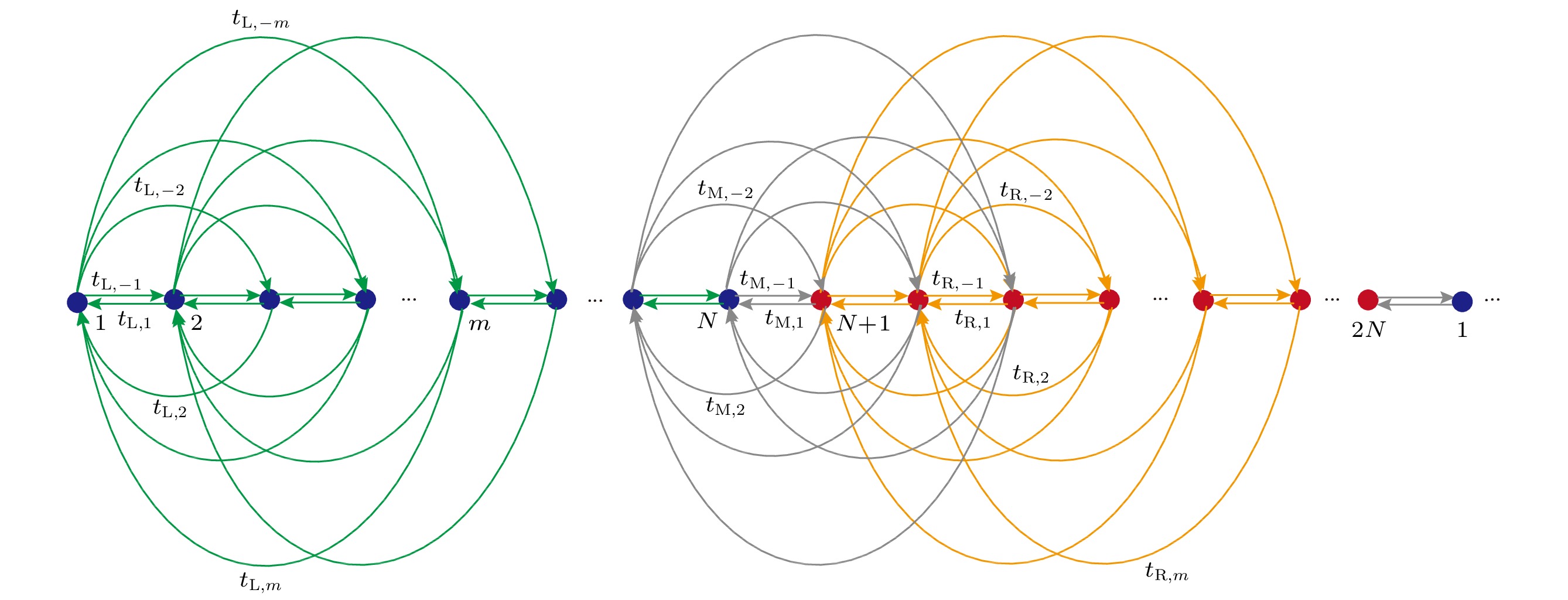
 下载:
下载:
